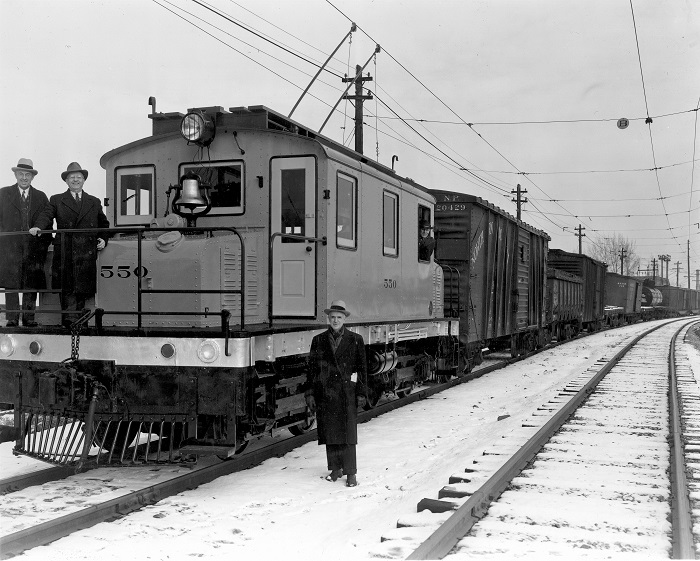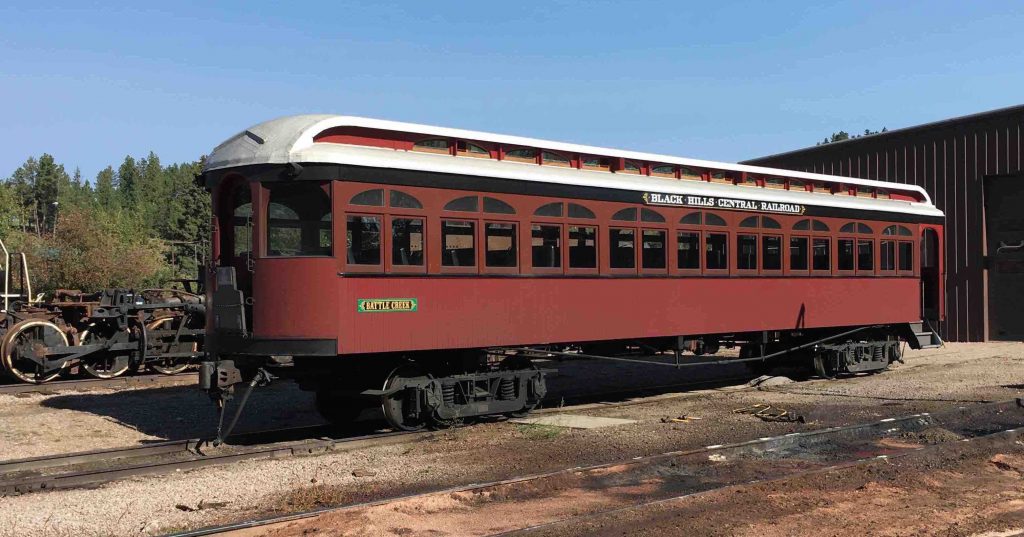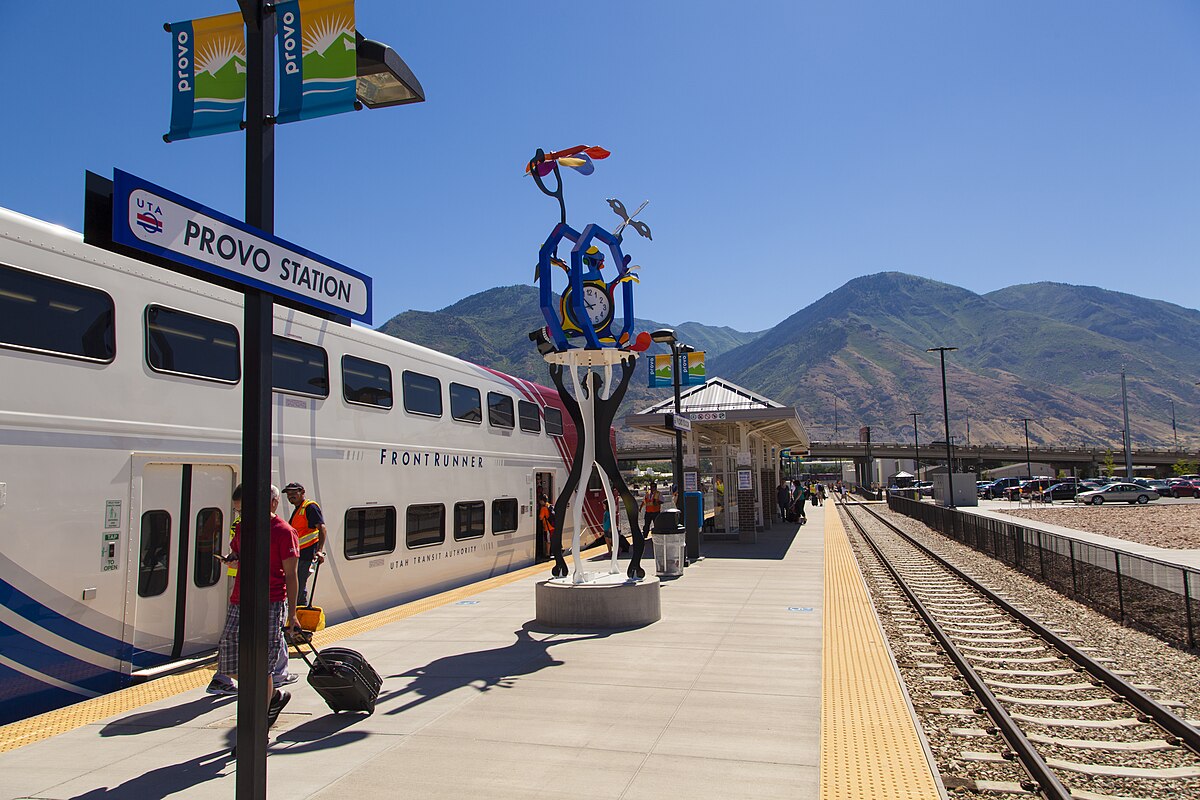On Tuesday, we gave a general overview of one of the most well-remembered Utah interurban roads, the Salt Lake & Ogden or Bamberger Electric Railway; today, we shed all of that and focus on the real reason why you probably read this weekly blog: the nitty-gritty of various types of trolleys. On this installment, while the rest of the Bamberger fleet is quite interesting to look at (featuring diesels with trolley poles), we'll be looking at one of the most interesting trolley cars to roam the US, and certainly one of the fastest ever built (even outclassing modern LRVs in speed). Load your magazine, fill your hand, and catch the speeding Bullet straight from Brill!
-----
 |
Bamberger's Jewett No. 355 and Niles 401 at Ogden, UT, July 1949
(Don Ross) |
Prior to reorganization, the Bamberger Railroad hosted over 50 Jewett- and Niles-built interurban cars and trailers between 1910 and 1916. The trailers were exclusively for Lagoon traffic and sat 80 people within, while the motors were all "composite" combination cars (Baggage-Smoker-Coach). Like the Salt Lake & Utah cars, all were primarily single ended but possessed a second cab and trolley pole for yard movements and wye-ing rolling stock at the end of the line. The Jewett-built cars were handsome wooden interurbans painted Pullman Green, while the Niles cars were all steel, and this would cause the roster some struggle when the Ogden carhouse burned in 1918 and decimated the wooden fleet. After a period of renumbering and rebuilding, many of the Niles trailers gained motors and what remained of the Jewett motor cars were rebuilt as one-manned, single-ended cars.
 |
Bamberger Railroad 550 (ex-San Diego Electric Railway) on
a chilly freight run, year unknown.
(Utah State Historical Society) |
One aspect not touched on on Tuesday was how the Bamberger got power to their trolley cars, and the simple answer was they used two wires on the single-track main, one "East" wire for Northbound trains and one "West" wire for Southbound trains. This was done to avoid using diverging overhead frogs (which a motorman would have to coast through or else they'd risk arcing across) and allow the power stations to provide adequate power without dropping due to the multiple trains on the line. This meant the Bamberger's 4 second-hand Baldwin-Westinghouse freight engines had two trolley poles installed to help balance power supply to the motors, something not usually seen on other equivalent interurban lines. These, and the Bamberger's other electric freight engines, were scrapped by 1952 after the railroad dieselized; however, during the transition period and just after, even the diesels were fitted with trolley poles to trigger signals and grade crossings.
 |
An HO representation of Bamberger's first diesel, ALCO RS-1 No. 570.
The unique hood was caused by an EMD rebuild in 1951.
(Model by Gordon Cardall, currently owned by Josh B.) |
 |
Bamberger (Ex FJ&G) 128 in Salt Lake City,
showing off its prominent streamlined brow
(Don Ross) |
Now, onto the good part. The J.G. Brill company of Philadelphia, PA, remains one of the most enterprising and innovative car companies to ever supply the US with rapid transit trolley cars. They are credited with the popular Birney Safety Car, which was created by their subsidiary American Car Co, as well as providing trolley cars and carbodies all over the world from Portugal to South Australia. Brill was also one to innovate, as they moved on to compete with the new PCC by creating the "Brilliner" (which was too square to navigate tight corners), the "Peter Witt car" (which was popular in Canada and Europe) and their many trolley bus designs that displaced many existing street railways. One of Brill's most striking designs, though, was dubbed the Brill "Bullet", and nothing else was like it on the rails.
 |
An original Brill advertisement for the Bullets,
this one for the Philadelphia & Western Railroad.
(Philadelphia NRHS) |
Unlike the curvy streamlined style of the PCC cars, the Brill Bullet was the first American railroad car designed in a wind tunnel. Thanks to a broad research program conducted by the Philadelphia and Western Railway, it was concluded that a faster, more streamlined, and lowered car could save on energy without needing bigger traction motors. The Bullets used the new Brill 89-E trucks, which rode on 28" wheels connected to 100-hp traction motors, and the low profile enabled the car to hit a maximum speed of 91 miles per hour, with the service speed being about 70 miles per hour. The design drew from the Cincinnati and Lake Erie's "Red Devil" high speed cars, to which the Brill 89-E trucks were derived from, as well as the Bullets' air-smoothed aircraft aluminum body. The car was displayed at the American Electric Railway Association in Atlantic City, NJ, in September, 1931.
The Bamberger's own Bullets originated on the Fonda, Johnstown, and Gloversville (FJ&G) Railroad, a 36-mile interurban running between Schenectady, Fonda, and Mountain Lake, New York. By the Bullets' debut in 1932, the line had rebuilt much of its infrastructure with new track, wires, and automatic substations, but needed to generate more profit due to drastic fare cuts and layoffs. Bullet 125 was the first of five (125-129) to reach Schenectady on a trial run, attracting thousands of viewers as it slashed the journey between Gloversville and Amsterdam Junction (a distance of 14 miles) from 93 minutes to 73 minutes. Despite advertising a journey time of 60 minutes, the public didn't care, and the profound efficiency of the cars helped save the FJ&G a ton of money. However, it wasn't enough as the FJ&G closed its electric division in 1938 after severe losses.
 |
Bullet No. 129 at Ogden with Jewett 302, showing just how
small and low to the ground the sporty Bullets were.
(John Smatlak) |
The Bullets operated admirably, like any other interurban with its share of accidents, but it was time for them to move on. In late February 1939, all five of FJ&G's bullets were headed for Salt Lake City. After some minor modifications to get them to run on 750V DC (a modern voltage now but unheard of for interurbans), the cars entered service that April with their original schemes and numbers intact. Utahns called them "Little Cars", as they were quite short (needing a pedestal for their trolley poles) and stubby compared to the Jewetts and Niles cars, and were well-liked for their smoothness and speed. The flat terrain between Ogden and Salt Lake City helped the Bullets reach high speeds effortlessly, as noted Bamberger motorman Gordon Cardall experienced when he took a 1949 fan trip aboard car 128 from Salt Lake City to Ogden in 38 minutes. This meant the 128 was hustling at an average speed of 56 miles per hour, despite "street running [...] two stops to meet opposing trains, and a dewirement in route which required a stop to replace the pole and inspect the overhead for damage." (John Smatlak)
 |
Bullet 125 departs Ogden with two heavyweight cars behind it, 1950.
Note the higher pole base to raise it the same level as the bigger interurbans.
(John Smatlak) |
Only one incident affected the high-speed cars during service on the Bamberger. Bullet 129 had the first train out of Ogden in the winter of late 1943 and was going down a 1.1% grade at service speed. Due to the intense speed, the car overshot its siding meet expecting a northbound train at Clearfield station and collided with heavyweight car 301. 129 had almost stopped by the time it reached 301, but sustained heavy damage, including the entire front platform collapsing. Thankfully, nobody was hurt, but 129 continued with a perpetually-sagging end after rebuilding. When the Bamberger Railroad ended passenger service in 1952, all five operating Bullets were sold to the Utah Pickle Company for use as bunkhouses in 1953. They were rebuilt with stoves and living quarters inside and continued to keep each other company in Layton, Utah until 1971.
 |
The OERM crew out at Layton, Utah in 1971, ready to remove
No. 127 for transport to Perris. Motorman Gordon Cardall
is in front of the headlight hole.
(John Smatlak) |
 |
Bamberger No. 127 in its new home at the OERM's Barn 2,
with shedmate Pacific Electric 331.
(Bob Vogel) |
In August 1971, the Utah Pickle Company reached an agreement with the Perris, California-based Orange Empire Railway Museum (now the Southern California Railway Museum) to have car No. 127 donated to the museum after several inspection visits in the 1960's. Gordon Cardall, now retired, was on-hand to watch the removal along with OERM volunteer and member John Smatlak. The 19 years of bunkhouse use left the car "almost entirely intact" according to Smatlak, and former Bamberger mechanical superintendent V.J. Crossley was contacted to obtain drawings for the brake and wiring prints. No. 127 sat in storage for the next two decades as sit was prepared for mechanical restoration. By August 12, 1995, the 127 sat on newly-kitbashed "Brill 89E3" trucks built from existing 89E1 and 89E2 trucks from SEPTA (which necessitated regauging and addition of traction motors). Today, No. 127 has been freshly repainted back to its original FG&J colors, but maintains its heritage as the Bamberger Bullet. Only time will tell if it can ever run again.
The other four bullets would find new homes around Utah as well, being purchased in 1972 by real estate developer Wally Wright for the "Trolley Square Shopping Mall", which was located in the original Utah Light & Railway Carbarns. Car 128 was modified for use as a sporting goods outlet, while 125 was shortened and used as the "Corn Dog" trolley. 125 affectionately became known as the "Bullet Birney" due to the single archbar truck it sat on. 128 later left Trolley Square for a gas station called "Trolley Station", while 125 was cut up under new ownership in 1986. Car 128 was later rebuilt again as the Art City Trolley Restaurant in Springville, 50 miles south of Salt Lake City in former Salt Lake & Utah territory, where it remains today.
 |
Ex-Bamberger No. 128 in its new guise as the Art City Trolley.
(Google Maps) |
 |
Ex-Bamberger No. 126 in storage at the Ogden Defense Depot
(Gino DiCarlo) |
The other two cars, 126 and 129, were in storage in Salt Lake City in preparation for Wally Wright's next project, but 126 was eventually bought by traction enthusiast Heinz Bruhl in 1978. The car was moved to his home in Ogden in June and repainted back into Bamberger colors at his autobody shop. After 10 years on display in his driveway, the Ogden Union Station Museum purchased the Bullet in 1988 and, while waiting for room in their main facility, currently remains displayed at the Ogden Defense Depot along with two former Saltair open cars. Car 129 has sadly since vanished some time in the 1980s.
The last surviving piece of the Bamberger worth mentioning is also the oldest. Trailer No. 403 was originally built by Jewett in 1910 as the second of that number and motored in 1929 as number 302. It was eventually sold to the Sons of Utah Pioneers and displayed at Pioneer Village in Salt Lake City until being moved to Corinne, UT, then the Heber Valley Railroad in 1994. The Creeper restored it back to its original Bamberger appearance in 1994, then sold it to the Black Hills Central Railroad in South Dakota for their "1880 Train" in 2012. Here, the car received extensive rehabilitation from Gomaco and is now in service as of 2016. So long as one Bamberger car still runs, so too will Simon Bamberger's electric railway never perish.
 |
| Ex-Bamberger 403, now Black Hills Central 403, "Battle Creek", in service in South Dakota |
-----
Thank you for reading today's Trolley Thursday coverage (in a roundabout way) of the Bamberger Railroad's passenger stock! I couldn't have done it without my Utah expert, Josh B, along with OERM Member John Smatlak's photos and articles and the photo collections and recollections of motorman Gordon Cardall. If you would like to donate to the Bamberger 127's eventual operation, click
here and earmark your donation for the car. If you want to ride on a real Bamberger car, follow the Black Hills Central's website
here. Next week, we look at the eye-catching Kennecott Railroad operations before closing the month with a discussion of Utah's smaller electric railroads. Until then, you can follow
myself or
my editor on twitter if you wanna support us, and maybe
buy a shirt as well! Ride safe!






/arc-anglerfish-arc2-prod-sltrib.s3.amazonaws.com/public/PIJMOGPDXNHTHEOQNVLKGGSU6U.jpg)






















